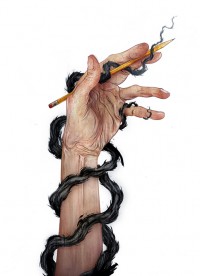Commentary by Karen J. Ohlson
The Eye-Popping Parts Are Not What You Think
Okay, I admit it. I wanted to see what all the fuss was about. And there it was on the “Hot Picks” shelf at my local library: Fifty Shades of Grey, Random House’s mind-bogglingly lucrative book of the year (decade? century?). I’d just heard on the radio that every Random House employee got a $5,000 end-of-year 2012 bonus thanks to this mega-seller by E L James.

I decided the opportunity to study this would be worth a little checkout desk embarrassment. After fleeing the librarian’s amused scrutiny, I was soon alone with the book on my couch, reading it in exactly the manner you might expect: flipping through its slow sections to get to the good stuff. You know…the parts about the contract.
What, you thought I was going to say “the sex scenes”? Hah.
Actually, Fifty Shades of Grey is the least erotic “erotica” I’ve ever encountered. Having finally read it, I now know that all the publishers jumping on the women’s erotica bandwagon because of this series have missed the point. Really missed the point.
The “will she or won’t she?” hot button isn’t about sex. This saga, with its romanticized control-freak hero, poses highly charged questions about what a woman should be willing to sacrifice—autonomy? privacy? friendship?—in order to be loved.
The Fifty Shades series started as Twilight fanfic, so it stands to reason that the key to its success lies not in how it differs from Twilight—the explicit sex scenes, the bondage—but in its similarity. Both are, at heart, the same story: The Thrilling Stalker Who Loves Me. An ordinary female protagonist finds that an immensely powerful, handsome man is irresistibly attracted to her. He’s also insanely controlling and tortured by a dark secret—a secret that will require her to give up her freedom if she wants to be with him.
Sure, decisions about whether to become a vampire love partner or a sex slave may seem pretty ridiculous, but they’re not unrelated to the more realistic decisions women make about what’s worth trading their independence for.
Hence, my fascination with “the contract”—and its ability to keep me reading a set of books (yes, dear reader, I eventually skimmed through all three) that I otherwise would have hurled across the room.
The contract is the highly restrictive agreement that Christian Grey (28-year-old CEO of Grey Enterprises and Seattle’s most eligible bachelor) wants college student Anastasia “Ana” Steele to sign before they embark on a relationship. But first, they “meet cute” when she interviews him for her school paper—and their attraction to each other is so intense that the relationship proceeds anyway, in the weeks during and following her college graduation (and in locations ranging from elevators to his boat house to his sex-toy-stocked Red Room of Pain), while the question of the contract hangs in the balance.
The sex scenes in this series are studded with awkward writing—”‘Argh!’ I cry as I feel a weird pinching sensation deep inside me as he rips through my virginity”—and often operatic beyond belief:
I erupt unexpectedly into a mind-blowing orgasm that stuns all my senses, obliterating all that’s happening outside my body as I writhe and groan.

Not to mention repetitive: Two pages after our heroine feels her body “convulsing and shattering into a thousand pieces,” she gets to “climax and splinter into a million pieces underneath him.” Damn, get this girl some Krazy Glue!
But the scenes in which Ms. Steele reacts to the contract sent by the dominating Mr. Grey early in the first book feel much more real.
If she signs it, the contract will compel her not only to submit to him sexually whenever he wants—though she can opt out of certain acts and devices—but also to follow his orders in a much wider range of matters, such as diet, sleep hours, and exercise schedule.
Regarding her beauty regimen, the contract states: “The Submissive will keep herself clean and shaved and/or waxed at all times.” As for her attitude: “The Submissive will conduct herself in a respectful and modest manner at all times.” The upshot?
Failure to comply with any of the above, will result in immediate punishment, the nature of which shall be determined by the Dominant.
Quite believably, Ana responds with amazement:
I swallow hard, my mouth dry, and read it again. My head is buzzing. How can I possibly agree to all this?… He’s my master! I’m to be dealt with as he pleases! Holy shit.
Moments like this brought the narrative to life for me. Unlike the clueless high school girl in Twilight, the 22-year-old narrator of Fifty Shades understands that the love of her life is an over-the-top control freak. She realizes the contract speaks of scenarios that would be “totally unacceptable” and asks herself, “Why am I even thinking about this?”
Why indeed. As I skimmed past the parts where her Dream Stalker’s hotness dissolves Ana Steele into a babbling puddle of “Oh my!” (or “Oh my,” or even, on occasion, “Oh fucking my”), I was propelled by my need—nay, my desperate longing—to know how E L James would resolve the question of female autonomy.
And I wanted to make sure the book that saved Random House’s bottom line wasn’t an account of an adult woman voluntarily signing away her free will to a smirking Master of the Universe whose catchphrase is “Laters, baby.”
As it turns out—spoiler alert!—nothing is truly resolved at the end of the first book. In the remaining two, Fifty Shades Darker and Fifty Shades Freed, Ana’s big question is no longer whether she should sign the contract; Christian eventually backs off on the paperwork, for fear of losing her.
However, she still has to figure out how to deal with a boyfriend (then fiancé, then husband) who orders her around, monitors her location and communications at all times, restricts her activities with friends and coworkers, and goes nuclear any time she defies his edicts. When she stands up to him, he can always trump her moves—as when he buys the publishing company that hires her after graduation so he can nix situations like a business trip with a male boss.
The truly disturbing aspect of this series is how James takes the controlling personality type that Dear Abby warns about in her “15 Signs of an Abuser” and romanticizes it even more than Stephenie Meyer did in her Twilight books. James gives her hero a childhood trauma that is meant to excuse everything.
“Oh, Christian,” Ana thinks tenderly, as he spreads lotion on her back during their Mediterranean honeymoon, “my possessive, jealous, control freak Christian.”

I’d like to believe that most of James’s 65-million-plus readers have been incredulous feminists like me, hoping against hope that the series would end in a non-nauseating way. However, the “Christian Grey for President” bumper sticker I saw the other day indicates otherwise, not to mention the recent rise in popularity of “Ana” and “Grey” as baby names. I’m guessing the readers behind these trends found the relationship in this series much more appealing than I did.
If the Freakin’ Hot Control Freak is the romantic template for the new millennium, that’s a scary thought (especially for the parent of a teenage girl—may my daughter forever scorn Twilight and its ilk!). Unfortunately, I’m convinced that the success of Fifty Shades is based more on this Stalkerlicious hook than on the rise of empowered women exploring the boundaries of their sexuality.
It’s not about the bondage, except as a metaphor. It’s about being the target of someone’s romantic obsession, even if the guy is “fifty shades of fucked up.” I doubt this is news to E L James fans, but the media has yet to get the memo. Witness the flap last week over ABC News labeling the “New Adult” genre—a YA subcategory aimed at Twilight and Fifty Shades readers—as “Smut Fiction.”
So, listen up, publishers. If you’re looking for the next blockbuster in romantic trilogies, you need to go beyond the handcuffs (and vampire fangs). You need a modest but irresistible heroine, a swoon-inspiring stalker with a shocking past, and a new gimmick.
Perhaps this would be the appropriate place to start building buzz about the novel I’m working on. Not to give anything away, but alien abduction plays a part in it, as do intergalactic love secrets and mind control, wielded by an unnervingly handsome time traveler traumatized by his ordeals in the fourth dimension.
Must all Earth women bend to his will? You’ll never believe what happens when he meets a klutzy, seemingly average female human named “Bellany”—who’s pissed as hell about the name I gave her. She’s read enough of Twilight and Fifty Shades to know what’s coming. So, she’s cooking up a little welcome concoction that’ll make Kryptonite look like a cap gun. Laters, baby.
- Fifty Shades of Grey, Fifty Shades Darker, and Fifty Shades Freed by E L James (Vintage/Random House, 2012); originally published as indie e-books in 2011 and 2012.
- “At Random House, Employees Will Enjoy 5,000 Shades of Green” by Leslie Kaufman, New York Times, December 6, 2012.
- “’50 Shades of Grey’ Inspires Popular 2012 Baby Names” by Christina Stiehl, Hollywood Life, November 29, 2012.
- “Emerging ‘New Adult’ Book Genre Puts Smut Fiction on Bestseller Lists” by Juju Chang, Nightline, ABC News, February 21, 2013.
 Karen J. Ohlson is a senior editor at Talking Writing. She doesn’t usually keep lists of “lessons learned” when reading novels, but she found the Fifty Shades series unusually instructive. Among its lessons:
Karen J. Ohlson is a senior editor at Talking Writing. She doesn’t usually keep lists of “lessons learned” when reading novels, but she found the Fifty Shades series unusually instructive. Among its lessons:
(1) CEOs make great boyfriends, because they always have time to exchange flirty emails during the workday.
(2) Don’t worry if a guy has major psychological issues—a few weeks of your love will succeed where therapists have failed. And finally…
(3) Go ahead—get a B.A. in English. You’ll get a great job in publishing right after graduation!
“I didn’t fall in love with Edward. In fact, I couldn’t stand him. Not for the obvious reason, but because of how he behaves in his relationship with Bella. He’s got some major Bad Boyfriend characteristics—ones I know I’d want my own daughter to see as warning signs.” — “The Real Trouble with ‘Twilight’”

